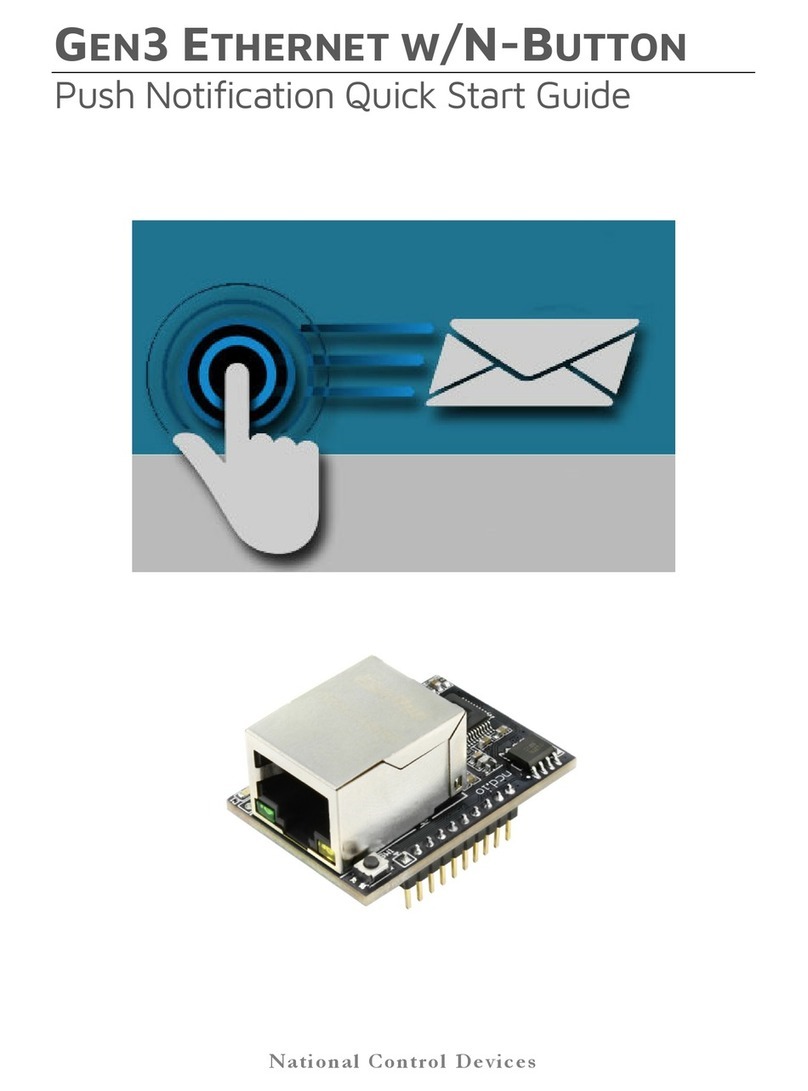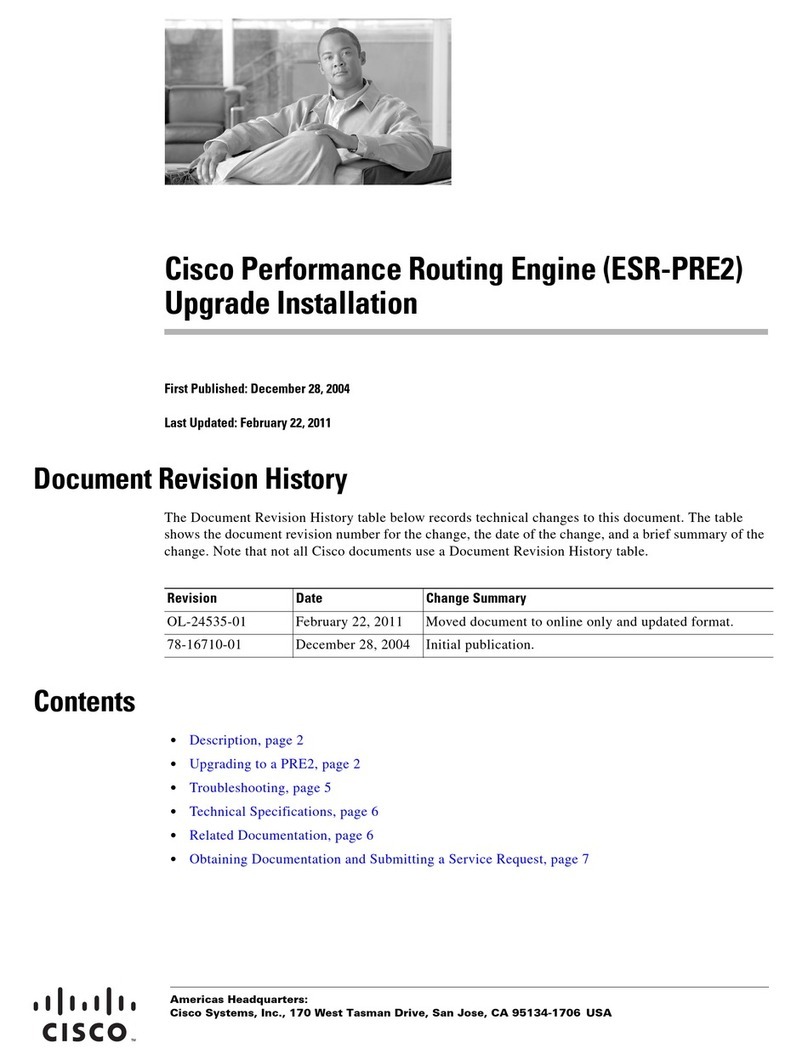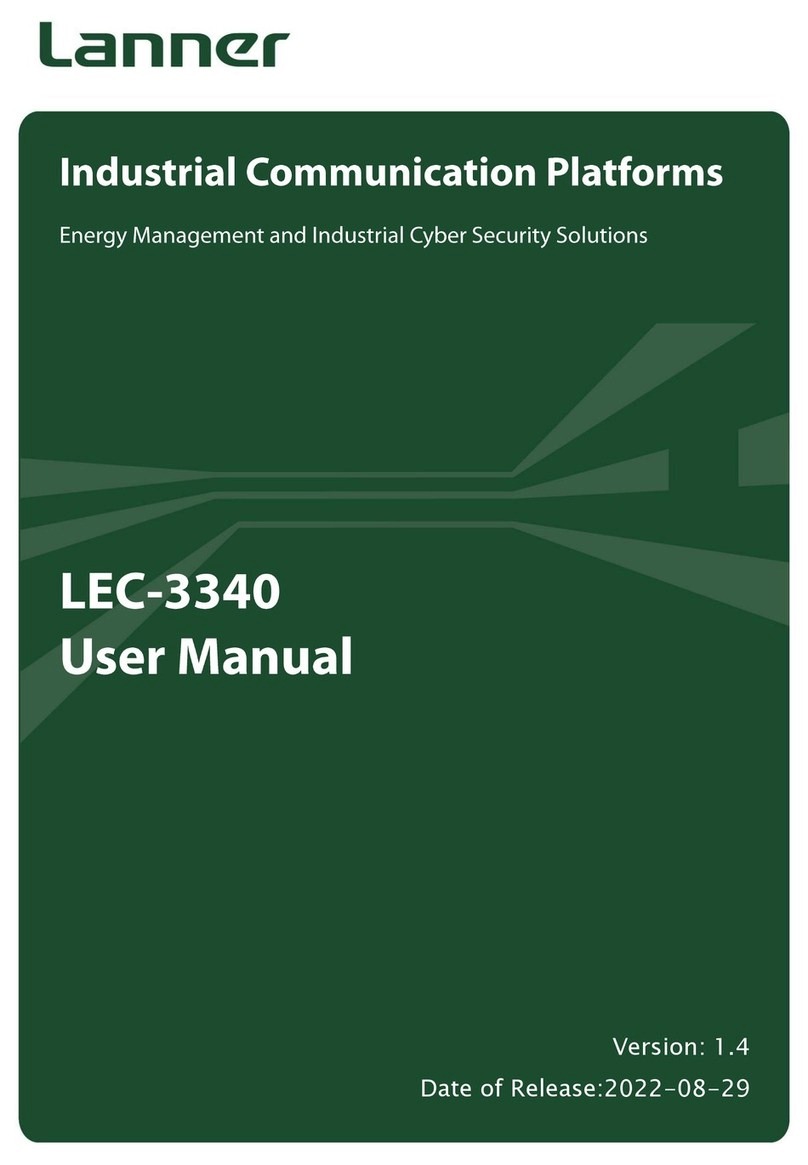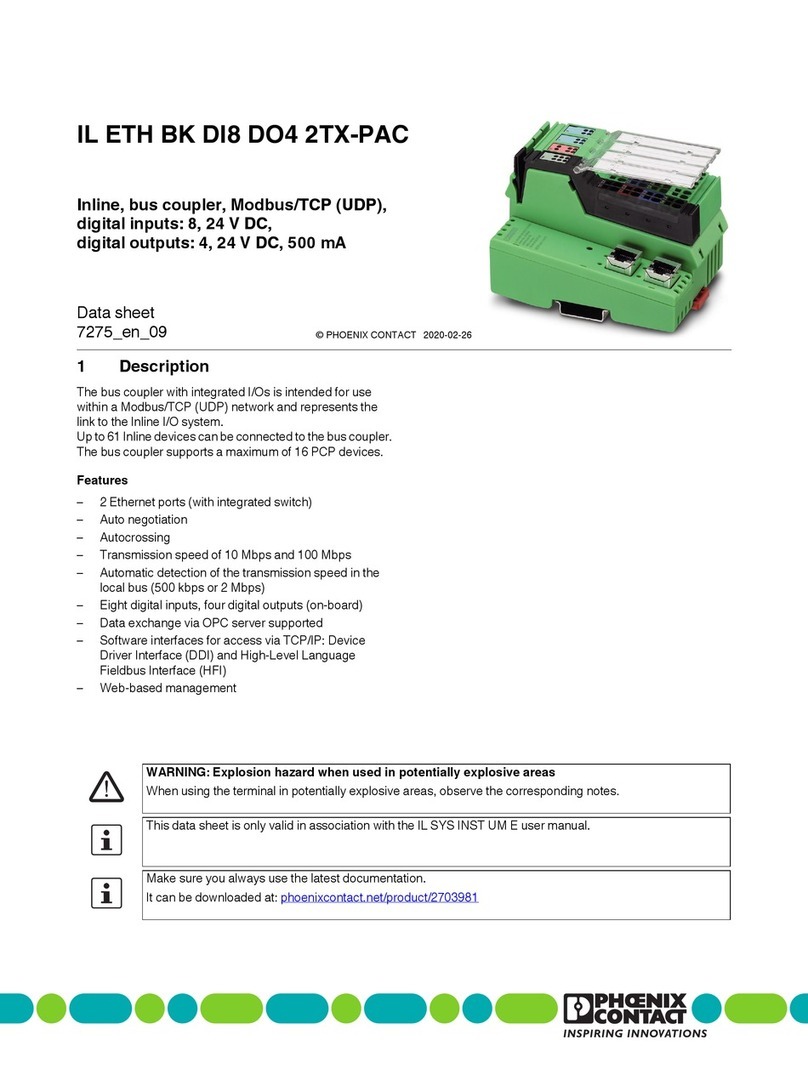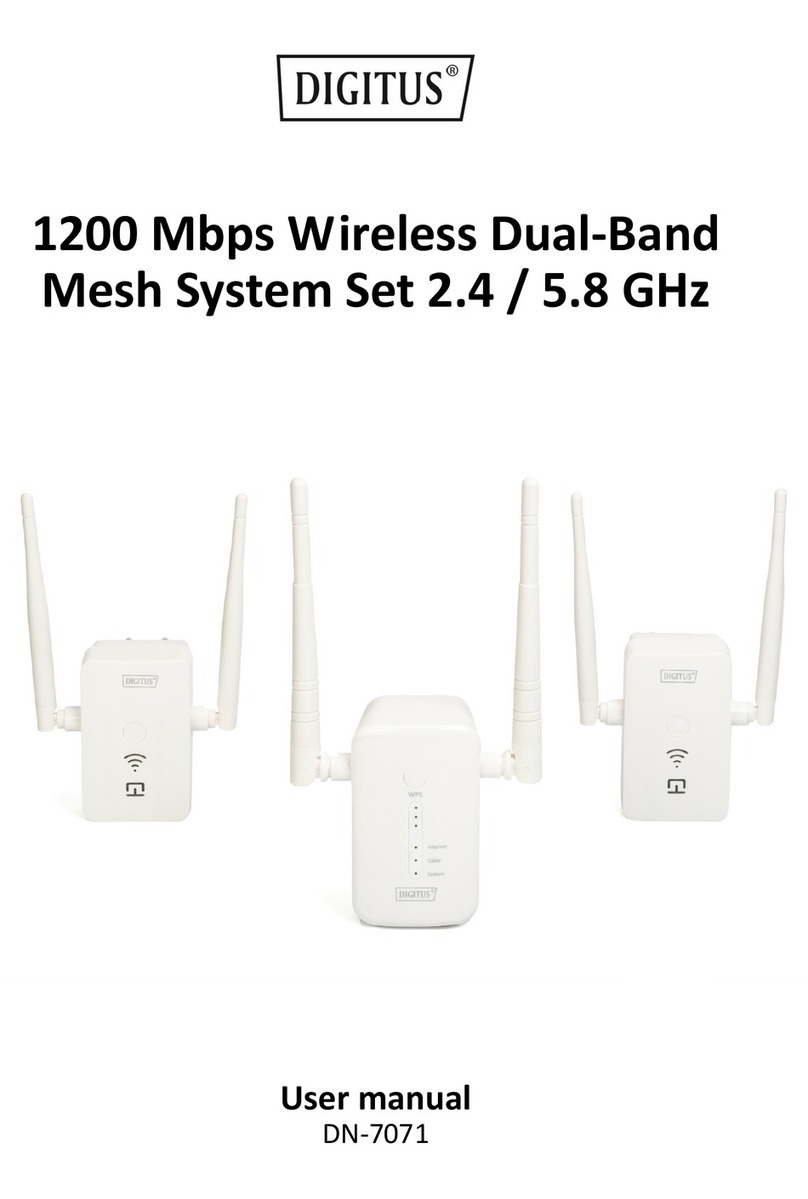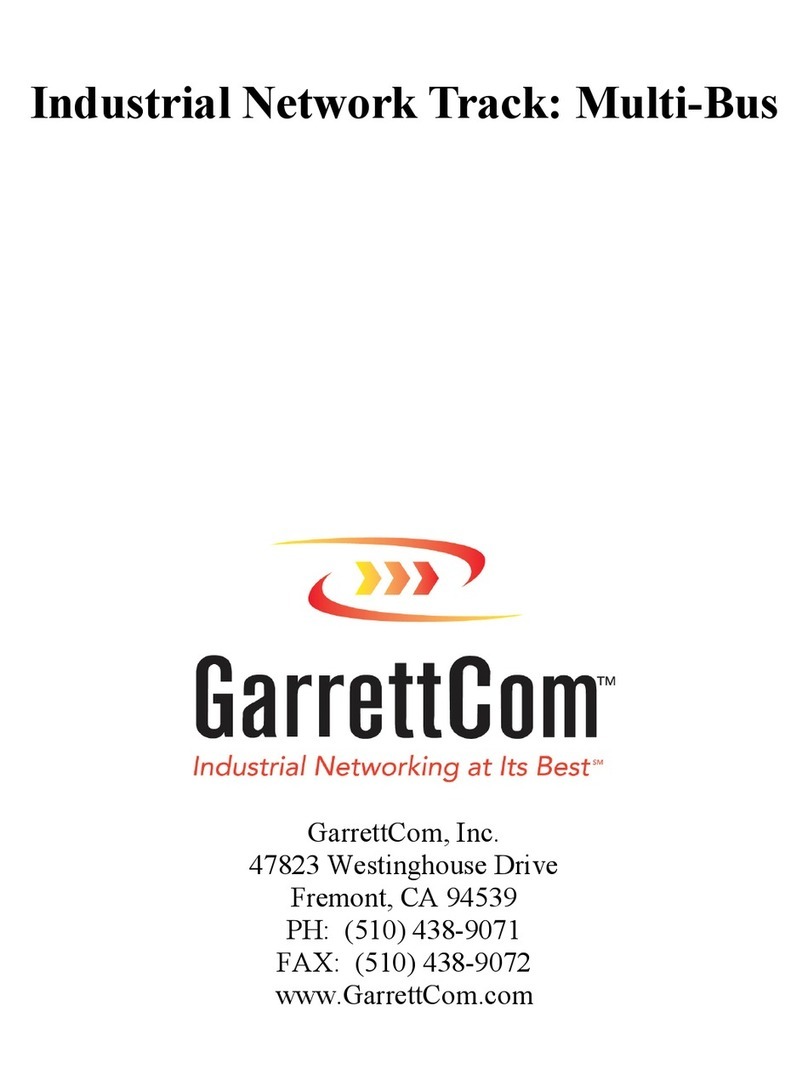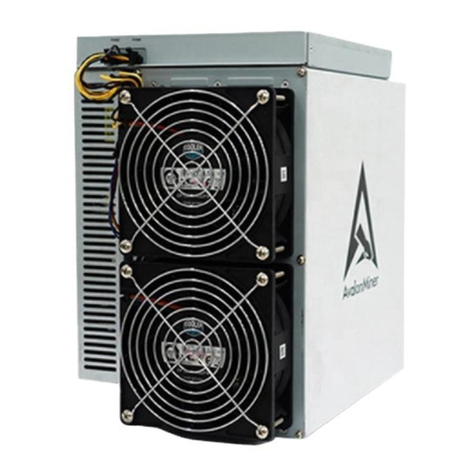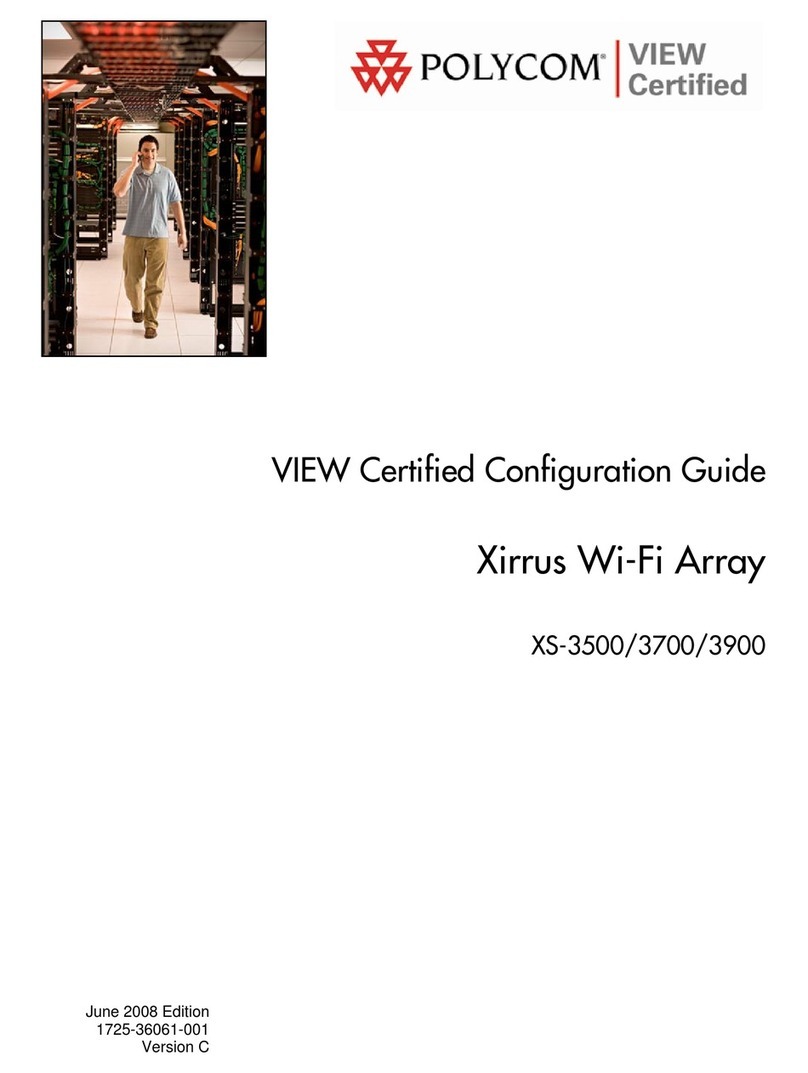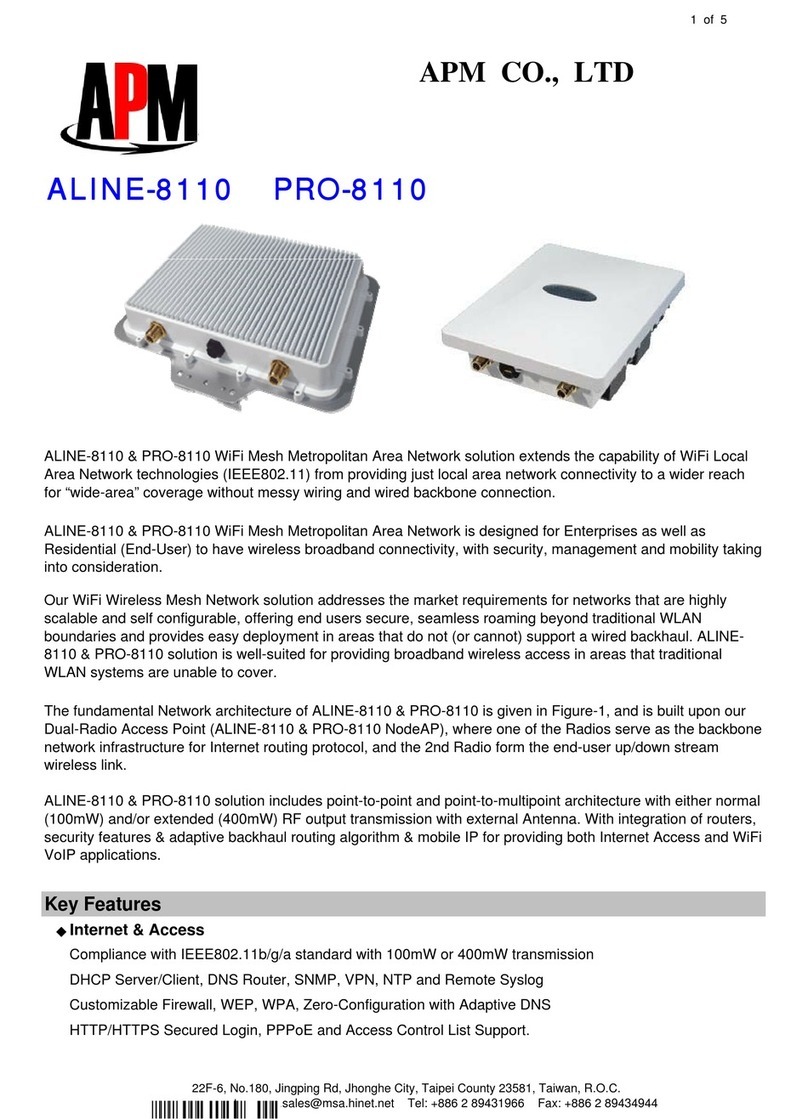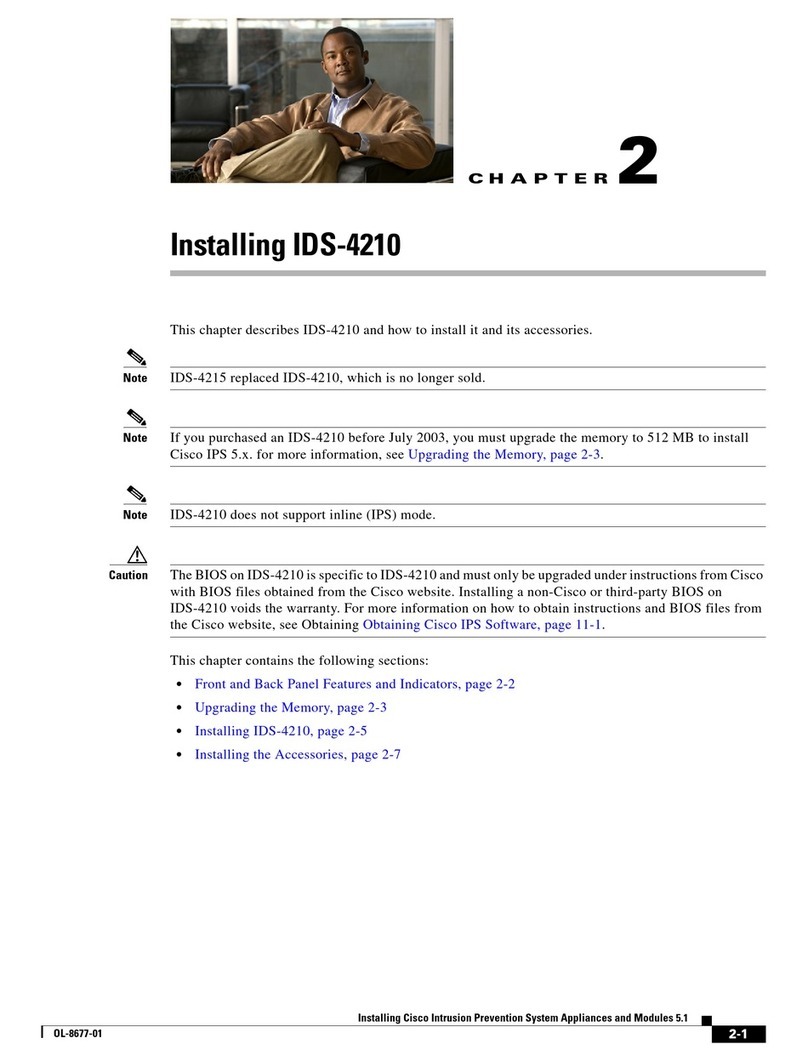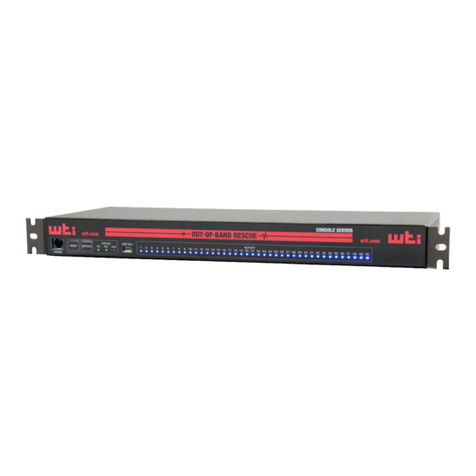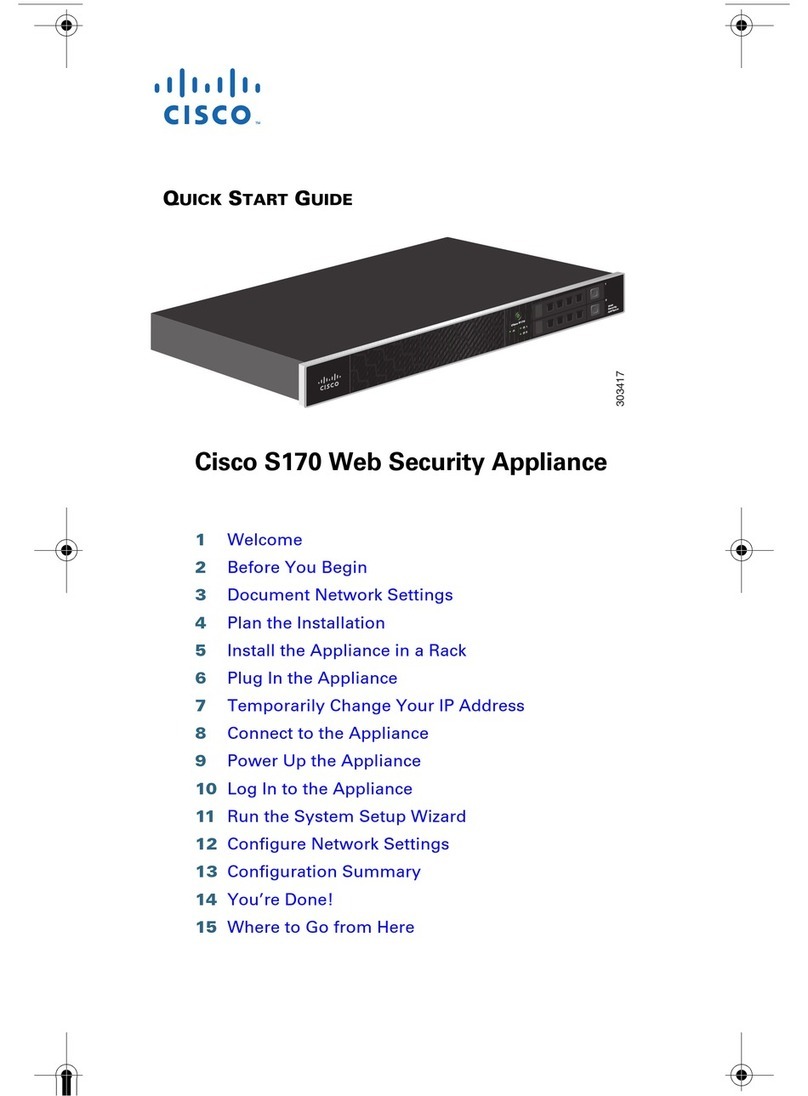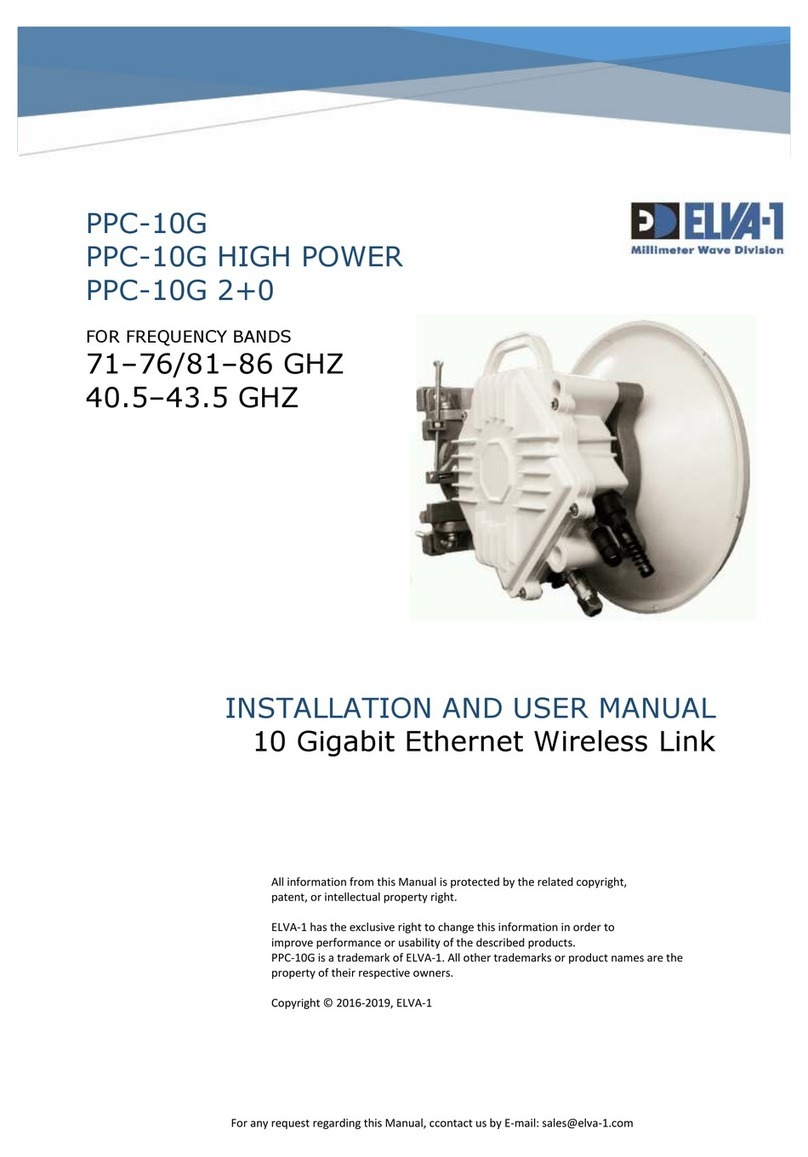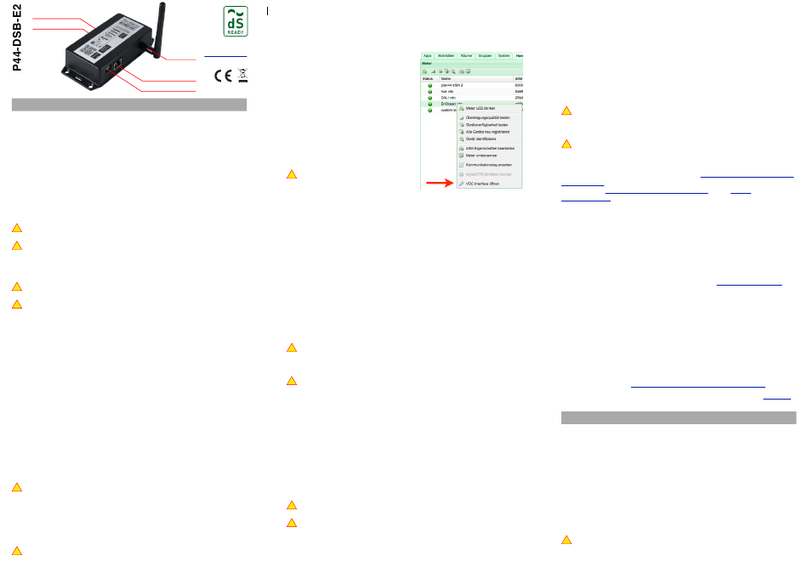General DataComm SpectraComm SDT User manual

The Best Connections in the Business
General DataComm
6SHFWUD&RPP#6'7#
Synchronous Data Transport
Installation & Operation Manual
076R174-000
Issue 4
May 2012

Copyright
©2012 General DataComm, Inc. ALL RIGHTS RESERVED.
This publication and the software it describes contain proprietary and confidential information. No part of this
document may becopied, photocopied, reproduced, translated or reduced to any electronic or machine-readable
format without prior written permission of General DataComm,Inc. The information in this document is subject
to change without notice. General DataComm assumes no responsibility for any damages arising from the use
of this document, including but not limited to, lost revenue, lost data, claims by third parties, or other damages.
If you have comments or suggestions concerning this manual, please contact:
General DataComm, Inc.
Technical Publications
6 Rubber Avenue
Naugatuck, Connecticut USA 06770
Telephone: 1 203 729 0271
Trademarks
All brand or product names are trademarks or registered trademarks of their respective companies or
organizations.
Documentation
Revision History - GDC P/N 076R174-000
Related Publications
-REV is the hardware revision (-000,-001, etc.)
-VREF is the most current software version (-V600 is Version 6.0.0.)
In addition to the publications listed above, always read Release Notes supplied with your products.
Issue Date Description of Change
1 July 2004 Initial Release
2 November 2005 Minor corrections
3 June 2011 Updates to cable pinout information
4 May 2012 Minor updates/enclosure branding
Description Part Number
SpectraComm 5000/UAS Shelf Installation & Operation Manual 010R302-REV
SpectraComm 2000 Shelf Installation & Operation Manual 010R358-REV
SpectraComm Standalone Enclosure Installation & Operation Manual 010R112-REV
SpectraComm Manager Card Installation & Operation Manual 048R303-REV
TEAM Core Software Operation Manual 058R720-VREF

076R174-000 SpectraCommSDT i
Issue 4 Installation and Operation Manual
Table of Contents
Preface
Safety Information ................................................................................................................... iv
Compliance ............................................................................................................................... v
Support Services and Training................................................................................................. vi
Corporate Client Services...................................................................................................vi
Factory Direct Support & Repair .......................................................................................vi
Contact Information ...........................................................................................................vi
Chapter 1: Introduction & Specifications
Product Overview .................................................................................................................. 1-1
Features & Benefits..........................................................................................................1-2
SC-SDT Interfaces/Connectivity......................................................................................1-3
Diagnostics and Statistics.................................................................................................1-3
Throughput Performance..................................................................................................1-3
SC-SDT Security..............................................................................................................1-4
Management.....................................................................................................................1-4
SC-SDT Front Panel Interface..........................................................................................1-5
SC-SDT Applications Overview............................................................................................ 1-6
A Transport Applications.................................................................................................1-7
A Contact Sense Applications..........................................................................................1-8
Technical Specifications........................................................................................................ 1-9
Chapter 2: Installation & Connections
Overview................................................................................................................................ 2-1
Unpacking Instructions.....................................................................................................2-2
Installing the SC-SDT ......................................................................................................2-4
Connections and Self-Test................................................................................................2-4
Interface Port Descriptions...............................................................................................2-6
Sync Ports.........................................................................................................................2-8
Chapter 3: SC-SDT Configuration
Configuration Overview ........................................................................................................ 3-1
Smart CLI Quick Reference.............................................................................................3-1
Initializing the SC-SDT for Configuration ............................................................................ 3-2
Accessing the Command Line Interface...........................................................................3-3
Setting Up User Accounts................................................................................................3-3
Configuring SC-SDT for Typical Applications..................................................................... 3-4
Basic Configuration..........................................................................................................3-4
Ports Configuration ..........................................................................................................3-7

ii SpectraCommSDT 076R174-000
Installation and Operation Manual Issue 4
Table of Contents
Chapter 4: The Web Interface
Introduction to Web Management......................................................................................... 4-1
Web Management Requirements..................................................................................... 4-1
Starting A Web Session ................................................................................................... 4-2
Command Line Web Screen............................................................................................ 4-3
Chapter 5: Additional Features
Overview of Additional Features .......................................................................................... 5-1
Time Protocols................................................................................................................. 5-1
TACACS+ Authentication Protocol ................................................................................ 5-2
Contact Sense ........................................................................................................................ 5-6
Monitoring Features .............................................................................................................. 5-8
System Message Log ....................................................................................................... 5-8
Alarm Log........................................................................................................................ 5-8
Management Status & Statistics ...................................................................................... 5-9
Port Status and Statistics................................................................................................5-10
Clear Functions ..............................................................................................................5-11
Chat Communication........................................................................................................... 5-11
SNMP Traps........................................................................................................................ 5-12
Appendix A:Application Guidelines
General Application Information.......................................................................................... A-1
Command Access Modes................................................................................................ A-1
Using Smart CLI................................................................................................................... A-5
Batch Up/Download Overview ............................................................................................ A-8
Troubleshooting Communications Problems ....................................................................... A-9

076R174-000 SpectraComm SDT iii
Issue 4 Installation and Operation Manual
Preface
Scope of this Manual
This manual describes how to install, configure and operate the SpectraComm Synchronous Data
Transport card. The information contained in this manual has been carefully checked and is
believed to be entirely reliable. This information is intended for installers, service technicians and
users and assumes a working knowledge in the design, planning and management of IP networks.
As General DataComm improves the reliability, function, and design of their products, it is possible
that the information in this document may not be current. Contact General DataComm, your sales
representative or point your browser to http:\\www.gdc.com for the latest information on
this and other General DataComm products.
General DataComm, Inc.
6 Rubber Avenue
Naugatuck, Connecticut 06770 U.S.A.
Tel: 1 203 729-0271 Toll Free: 1 800 523-1737
Manual Organization
This manual is divided into the following chapters. When using the digital version of this manual,
click on any link (shown in blue text) to jump to that section.
•Chapter 1, Introduction & Specifications
describes the SpectraComm SDT features and options. This chapter contains an overview of
product design, intended use and technical specifications.
•Chapter 2, Installation & Connections
provides directions for installing the SC-SDT in a SpectraComm shelf system or enclosure.
•Chapter 3, SC-SDT Configuration
describes terminal, Telnet, and CLI interfaces used to configure and control the SC-SDT.
•Chapter 4, The Web Interface
describes the web-based (HTTP) interface and web-based CLI used to configure and control
the SC-SDT operation in a SpectraComm shelf.
•Chapter 5, Additional Features
describes the configuration or use of additional SC-SDT features, such as Time Protocols,
TACACS+ Authentication Protocol, Contact Sense, the Telnet Menu, System Message Log
and Alarm Log, SNMP Traps, and Connect/Disconnect Controls.
•Appendix A, Application Guidelines
provides useful information on SC-SDT factory defaults, access modes, the command line
interface and any special application considerations.

Preface Safety Information
iv SpectraCommSDT 076R174-000
Installation and Operation Manual Issue 4
Safety Information
This manual should be read in its entirety and all procedures completely understood before
installing or operating the unit, including all notes, cautions and warnings (examples below). The
CAUTION, WARNING, and DANGER statements that appear throughout this manual are
intended to provide critical information for the safety of both the service engineer and operator.
These statements also enhance equipment reliability. The following definitions and symbols for
CAUTION, WARNING, and DANGER as they are used comply with ANSI Z535.2, American
National Standard for Environmental and Facility Safety Signs, and ANSI Z535.4, Product Safety
Signs and Labels, issued by the American National Standards Institute. .
Safety Guidelines
• Always use caution and common sense, especially when unsafe conditions or potentially
hazardous voltages are present.
• Repairs must be performed by qualified service personnel only.
• To reduce the risk of electrical shock, do not operate equipment with the cover removed.
• Never install telephone jacks in a wet location unless the jack is designed for that location.
• Never touch uninsulated telephone wires or terminals unless the telephone line is
disconnected at the network interface.
• Never install telephone wiring during an electrical storm.
Antistatic Precautions
This product may contain static-sensitive devices that are easily damaged by ESD (electrostatic
discharge). ESD occurs when a person whose body has built up static electricity touches a computer
component. ESD can cause computer components to fail. Take proper handling, grounding and
precautionary ESD measures when installing parts or cards. Keep parts and cards in antistatic
packaging when not in use or during transport. If possible, use antistatic pads on floor and
workbench. When handling components, always use an antistatic wrist strap connected to a
grounded equipment frame or chassis. If a wrist strap is not available, periodically touch an
unpainted metal surface on the equipment. Never use a conductive tool, like a screwdriver or a
paper clip, to set switches.
Note Indicates a note. It is something you should be particularly aware of; something not readily apparent.
A note is typically used as a suggestion.
Important Indicates an emphasized note. It is something you should be particularly aware of; something not readily
apparent. Important is typically used to prevent equipment damage.
CAUTION indicates conditions or practices that can cause damage to equipment or loss of
data.
WARNING indicates an imminently hazardous situation which, if not avoided, may result
in minor to moderate injury. It may also be used to alert against unsafe practices.
DANGER indicates an imminently hazardous situation which, if not avoided, will result in
death or serious injury.

Preface Compliance
076R174-000 SpectraComm SDT v
Issue 4 Installation and Operation Manual
Compliance
FCC Part 15 (Pending)
This device complies with Part 15 of the FCC rules. Operation is subject to the following
conditions:
1. This device may NOT cause harmful interference, and
2. This device must accept any interference received, including interference that may cause
undesired operation.
Electromagnetic Compatibility
This Class A digital apparatus complies with FCC Part 15 and Canadian ICES-003.
La Compatibilité d’ Eléctro-magnetique
Cet appareil numerique de la classe A est conforme a la norme NMB-003 du Canada.
NEBS Compliance (Pending)
Designed to be compliant to the following NEBS standards:
GR63 - Physical Protection
GR78 - ESD
GR1089 - EMC and Safety

Preface Support Services and Training
vi SpectraCommSDT 076R174-000
Installation and Operation Manual Issue 4
Support Services and Training
GeneralDataCommofferstwocomprehensive customersupportorganizationsdedicatedtopre-and
post-sale support services and training for GDC products. Corporate Client Services and Factory-
Direct Support & Repair assist customers throughout the world in the installation, management,
maintenance and repair of GDC equipment. Located at GDC’s corporate facility in Naugatuck,
Connecticut USA, these customer support organizations work to ensure that customers get
maximum return on their investment through cost-effective and timely product support.
Corporate Client Services
Corporate Client Services is a technical support and services group that is available to GDC
customers throughout the world for network service and support of their GDC products. Customers
get thereliable supportand training required for installation, management and maintenance of GDC
equipment in their global data communication networks. Training courses are available at GDC
corporate headquarters in Naugatuck, Connecticut, as well as at customer sites.
Factory Direct Support & Repair
GDC provides regularand warranty repair services through Factory Direct Support & Repair at its
U.S. headquarters in Naugatuck, Connecticut. This customer support organization repairs and
refurbishes GDC products, backed by the same engineering, documentation and support staff used
to build and test the original product. Every product received for repair at Factory Direct Support
& Repair is processed using the test fixtures and procedures specifically designed to confirm the
functionality of all features and configurations available in the product.
As part of GDC’s Factory Direct program, all product repairs incorporate the most recent changes
and enhancements from GDC Engineering departments, assuring optimal performance when the
customer puts the product back into service. Only GDC’s Factory Direct Support & Repair can
provide this added value.
Contact Information
General DataComm, Inc.
6 Rubber Avenue
Naugatuck, Connecticut 06770 USA
Attention: Corporate Client Services
Telephones: 1 800 523-1737
1 203 729-0271
Fax: 1 203 729-3013 or 1 203 729-3014
Email: c[email protected]m
General DataComm, Inc.
6 Rubber Avenue
Naugatuck, Connecticut 06770 USA
Attention: Factory Direct Support & Repair
Telephones: 1 800 523-1737
1 203 729-0271
Fax: 1 203 723-2883
Email: factorydirect@gdc.com
Hours of Operation:
Monday - Friday 8:30 a.m. - 5:00 p.m. EST
(excluding holidays)
http://www.gdc.com

076R174-000 SpectraComm SDT 1-1
Issue 4 Installation and Operation Manual
Chapter 1: Introduction &
Specifications
Product Overview
The SpectraComm Synchronous Data Transport (SC-SDT) is designed primarily for synchronous
data transport for encapsulating packetized, HDLC-based sync data traffic onto Ethernet facilities
over private IP networks. The SC-SDT also performs alarm sensing via contact relays. A future
release will support alarm reporting between locations over the network. SC-SDT provides multi-
level password protection and ethernet access features that enhance the security of the customer’s
network.
Intended Use
The SC-SDT card is a single-width, 7-inch by 9.5-inch (178 mm by 241 mm) printed circuit card
designed for installation inGDC’s“telco-tough” SpectraComm shelves: thetwo-slot SpectraComm
2000 shelf or the 16-slot SpectraComm/UAS shelf. For remote site or non-NEBS, stand-alone
applications, the same SC-SDT 3-portcardinstalls easilyin the single-slot SpectraCommAC orDC
standalone enclosure.Typicalshelfconfigurations can includeSC-SDTdeviceswithSpectraComm
routers, switches, modems, DSUs, LTUs and multiplexers.
Figure 1-1 Typical SC-SDT Shelf Configurations
V.F 28.8
LL
RL
DL
SEL
TXD RXD
RTS CTS
DCD GD
TM ALM
DTR OH
NR ND
ADV
ST
SC-ES
18-PORT
ETHERNET SWITCH
8
7
6
5
4
3
2
1
17
16
15
15
13
12
11
10
9ON18
SCM
CTRL
SD RD
SD RD
NR ND
TM ALM
INS ON
L
A
N
W
A
N
V.F 28.8
LL
RL
DL
SEL
TXD RXD
RTS CTS
DCD GD
TM ALM
DTR OH
NR ND
ADV
ST
POWER
ON
FAIL
GPS-11
POWER
SUPPLY
ON
OFF
POWER
ON
FAIL
GPS-11
POWER
SUPPLY
ON
OFF
SC-IP
INS ON
MODEM
T1
AUX
T
XR
X
TM ALM
C
R
A
F
T
P
O
R
T
1
ETHERNET
P
O
R
T
2
21
General
DataComm
L
I
N
E
I
N
O
U
T
M
O
N
RSP
SD RD
EQ
BPV AIS
OOF NS
T1
CH
RL
553
L
I
N
E
I
N
O
U
T
M
O
N
RSP
SD RD
EQ
BPV AIS
OOF NS
T1
CH
RL
553
SC Standalone
Enclosure
(1 Slot)
SpectraComm SDT
Devices
Compatible SC DevicesPower
Supplies
SpectraComm SDT
Device
SC 5000/UAS
Shelf
(16-Slots)
SpectraComm SDT
Devices Power
Supplies
SC 2000
Shelf
(2 Slots)
PORT 1
INS
PORT1
PORT2
PORT 2
SC SDT
PORT 3
ON
PORT3 AL
TM
ET
PORT 1
INS
PORT1
PORT2
PORT 2
SC SDT
PORT 3
ON
PORT3 AL
TM
ET
PORT 1
INS
PORT1
PORT2
PORT 2
SC SDT
PORT 3
ON
PORT3 AL
TM
ET
PORT 1
INS
PORT1
PORT2
PORT 2
SC SDT
PORT 3
ON
PORT3 AL
TM
ET
PORT 1
INS
PORT1
PORT2
PORT 2
SC SDT
PORT 3
ON
PORT3 AL
TM
ET
PORT 1
INS
PORT1
PORT2
PORT 2
SC SDT
PORT 3
ON
PORT3 AL
TM
ET
PORT 1
INS
PORT1
PORT2
PORT 2
SC SDT
PORT 3
ON
PORT3 AL
TM
ET
PORT 1
INS
PORT1
PORT2
PORT 2
SC SDT
PORT 3
ON
PORT3 AL
TM
ET
PORT 1
INS
PORT1
PORT2
PORT 2
SC SDT
PORT 3
ON
PORT3 AL
TM
ET
PORT 1
INS
PORT1
PORT2
PORT 2
SC SDT
PORT 3
ON
PORT3 AL
TM
ET
PORT 1
INS
PORT1
PORT2
PORT 2
SC SDT
PORT 3
ON
PORT3 AL
TM
ET

Introduction & Specifications Product Overview
1-2 SpectraComm SDT 076R174-000
Installation and Operation Manual Issue 4
Features & Benefits
• Provides authenticated, high performance, low-cost transfer of packetized, HDLC-based sync
data between sites utilizing IP networks.
• Scalable, individually configurable ports in three-port increments.
• Provides alarm reporting for contact sensing.
• Supports LAN connection to 10/100Base-T Ethernet.
• Supports efficient configuration of multiple SC-SDT devices via ASCII batch file upload/
download.
• Diagnostics for ping and statistics.
• Employs GDCs “Smart CLI,” an interactive command line interface, and a web-based CLI
interface.
• Ethernet port auto-negotiates for 10 or 100 Mbps port speed, full- or half-duplex modes and
enabled/disabled flow control.
• Ethernet port auto-senses (HP MID/X) for straight-thru or crossover cable connections.
• High performance “run from ram” architecture includes a running version, a primary version
and standby version of software.
• Provides a DB25 connector for Contact Sense and as a console port for local management.
• Supports remote management using standards-based IP protocols including Telnet, TFTP, and
HTTP (Web).
• Supports discovery, statistics, and alarm traps using standards-based SNMP.
• Supports multi-level password protection for added security.
• Supports TACACS+ authentication for centralized username and password administration.
• Softwareupgradeable via TFTP, allowing quick bug fixes and feature enhancements overtime.
• Low power consumption (5 watts maximum per slot).
• Designed for NEBS Level III compliance.
• Chat Call/Chat Hello protocol allows text communication between two users.
Future Enhancements
A future release of the SC-SDT will offer the following additional capabilities:
• contact outputs between network locations.
• sync loopback diagnostics
• alarm trap for EIA control leads of sync ports
• Etherswitched backplane support

Introduction & Specifications Product Overview
076R174-000 SpectraComm SDT 1-3
Issue 4 Installation and Operation Manual
SC-SDT Interfaces/Connectivity
The typical installation environment for the SC-SDT device is a SpectraComm 5000/UAS shelf,
SpectraComm 2000 shelf, or any model of the SpectraComm standalone enclosures. In these shelf/
enclosure systems, the SC-SDT provides multiple physical interfaces, described below. The SC-
SDT is shipped from the factory with all ports set to Disabled.
Note Refer to Figure2-1for detailed views and information on rear panel connections to the SC-SDT in the various
GDC shelves and enclosures.
Craft Port/Contact Sense
The rear panel DB25 RS-232 craft interface supports contact sense connections. It also supports
local configuration and monitoring via fixed serial async 9600 baud, 8 data, 1 start/stop, no parity.
Ethernet 10/100BASE-TX LAN Ports (Logical E0)
A rear panel RJ45 connector provides the Ethernet (LAN) interface for connecting the SC-SDT to
any standard 10/100B-T LAN device, including PCs, servers, hubs and switches.
Transport Ports
Three high density 26-pin “smart” serial connectors provide the front panel DTE or DCE interface
for packetized, HDLC-based synchronized data transport. Six serial interfaces are supported: EIA/
TIA-232, EIA/TIA-449, X.21 and V.35 in both DTE and DCE modes; and EIA530 or EIA530A in
DTE mode only.
Diagnostics and Statistics
• Generates/answers pings
• Tests Contact States
• Transmit and Receive packet counts on Ethernet interface
• Transmit and Receive byte counts on Ethernet interface
• Transmit and Receive packet and byte counts on Sync ports
Throughput Performance
Typical Throughput Conditions
It is expected that the traffic patterns of typical applications will be bursty in nature, thereby
allowing all three sync ports to deliver data without loss under typical traffic conditions
Application (Protocol) Flow Control
It is expected that the customer's end-devices provide a flow control mechanism at the application
level. Some example applications (or protocols) that provide this capability are FTP and X.25.
These end applications will hold-off data transmission to avoid traffic loss while maximizing
throughput across the network.
Worst-case Throughput Conditions
Duringextreme traffic conditions,theSC-SDTwillhandleanaggregaterateof 3Mbps,fullduplex.
This translates to 1Mbps per port if using all three ports under worst-case conditions.
Note Extreme traffic conditions are defined as continuous sync data (i.e. non-bursty) with application flow-control
required.

Introduction & Specifications Product Overview
1-4 SpectraComm SDT 076R174-000
Installation and Operation Manual Issue 4
SC-SDT Security
SC-SDT devices are multi-level password-protected and also provide inactivity timers. For periods
of heightened security, authorized users can configure access controls to filter out specific
protocols, such as HTTP, SNMP and/or TFTP access to the unit.
Management
Smart CLI Management
The SC-SDT employs an interactive command line interface that will feel familiar to most field
personnel. Added features include auto-prompting for command arguments, recognition of
abbreviated commands, online help, command line recall and an advanced utility for generating
downloadable ASCII configuration files.
Telnet Management
The SC-SDT provides password-protected Telnet access from anywhere in the network via
Ethernet LAN connection at the rear panel. A customer-supplied router is required at the SC-SDT
location.
Web Management
The SC-SDT supports direct password-protected web management via HTTP for internet-ready
network monitoring. An embedded web server agent allows Read or Read-Write access to the SC-
SDT using popular browsers. To enhance security, the SC-SDT supports web time-outs and
password-protected access over the web interface. HTTP services can also be disabled to block web
access to SC-SDT devices.
SNMP Management
An embedded SNMP agent allows discovery by the SpectraComm Manager (SCM) card, retrieval
of statistics, and alarm traps, and supports SNMP MIB-2 (RFC1213). SNMP access can be disabled
to avoid hacks during intervals of heightened security.
Note SNMP support does not require a SpectraComm Manager (SCM) co-located in the shelf with the SC-SDT.
TEAM Management
(Future Release)
A future release of the SC-SDT will support auto-discovery and polling by GDCs TEAM software
(Total Enterprise Access Management). TEAM uses HPOV APIs (Application Programmer
Interfaces) to integrate with HP OpenView Windows and other network management applications.
The SC-SDT will also be able to launch a direct Telnet or web-based CLI session from the map
window. For more information on the availability and operation of these additional features, refer
to later issues of this document or contact your GDC Sales Representative.
Note TEAM support requires an SCM card at version 5.80 or greater and co-located in the shelf with the SC-SDT.
For more information, refer to the GDC TEAM Core documentation and Release Notes.

Introduction & Specifications Product Overview
076R174-000 SpectraComm SDT 1-5
Issue 4 Installation and Operation Manual
SC-SDT Front Panel Interface
Port LEDs indicate the activity and/or status of the device, the ethernet interface, and of the
individual ports. The table below describes the LED states.
Table 1-1 Front Panel Connectors and Indicators
SC-SDT Front
Panel Description
ON Steady GREEN indicates power is supplied to the unit.
INS Steady GREEN indicates the device is operational and running an
active application.
LAN Steady GREEN indicates the associated ethernet link is up.
LED OFF indicates the associated ethernet link is down.
Flashing GREEN indicates the associated ethernet link is
receiving/transmitting data.
PORTS 1- 3 Steady GREEN
Port is configured and a transport link between two SC-SDT
devices is established.
Flashing GREEN
Port is configured, a transport link between two SC-SDT devices is
established, and data is passing on the link.
LED OFF
Port is not configured, or
Port is configured but the transport link between two SC-SDT
devices is not established.
TM (Test Mode) Steady RED when unit is performing loopback or diagnostics.
(Future use)
ALM (Alarm) Steady RED when unit is in a major alarm condition.
(Future use)
PORT 1
INS
PORT1
PORT2
PORT 2
SC SDT
PORT 3
ON
PORT3 AL
TM
ET

Introduction & Specifications SC-SDT Applications Overview
1-6 SpectraComm SDT 076R174-000
Installation and Operation Manual Issue 4
SC-SDT Applications Overview
The SpectraComm Synchronous Data Transfer device (SC-SDT) is designed primarily for
packetized, HDLC-based Synchronous Data Transport applications and Contact Sense
applications. The NEBS-compliant SC-SDT can be deployed anywhere in the IP network where
synchronous devices, craft port equipment or contact relays are located.
• DTE/DCE devices at any SC-SDT site can exchange sync data with devices at other SC-SDT
sites.
• From the Management Station, all SC-SDT units are managed via Telnet and HTTP.
Password-protected local (craft) access is also supported.
• The rear panel DB-25 connector provides contact ports for alarm traps. Ina future release of the
device, alarm transfer between locations will be supported.
Figure 1-2 shows the SC-SDT at remote sites supporting multiple applications simultaneously.
Each application is detailed in the pages that follow the figure.
Figure 1-2 SpectraComm SDT End-to-End Applications
Contact Relay Ports
Ports 1 - 8
PORT1
INS
PORT1
PORT2
PORT2
SC SDT
PORT3
ON
PORT3 AL
TM
ET
PORT1
INS
PORT1
PORT2
PORT2
SC SDT
PORT3
ON
PORT3 AL
TM
ET
General
DataComm
Sync equipment at all SC-SDT sites can
exchange data across the IP network.
SC-SDT SITE 'C'
SC-SDT SITE 'B'SC-SDT SITE 'A'
ROUTER
or SCIP ROUTER
or SCIP
ROUTER
or SCIP
Contact Relay Ports
Ports 1 - 8
NOTE: SC-SDT devices installed
in a 2-slot SC 2000 shelf.
Centralized
SC-SDT Management
DTE/
DCE DTE/
DCE DTE/
DCE DTE/
DCE DTE/
DCE
DTE/
DCE
General
DataComm
PORT1
INS
PORT1
PORT2
PORT2
SC SDT
PORT3
ON
PORT3 AL
TM
ET
DTE/DCE
DTE/DCE
DTE/DCE
PORT1
INS
PORT1
PORT2
PORT2
SC SDT
PORT3
ON
PORT3 AL
TM
ET
Port 1 Sync
Port 3 Sync
Port 2 Sync
DTE/DCE
DTE/DCE
DTE/DCE
IP
NETWORK

Introduction & Specifications SC-SDT Applications Overview
076R174-000 SpectraComm SDT 1-7
Issue 4 Installation and Operation Manual
A Transport Applications
The synchronous transport application of the SC-SDT links equipment together over thecustomer's
IP network. The SC-SDT encapsulates the packetized, HDLC-based sync traffic and forwards the
data over Ethernet using TCP/IP. The sync data at any local SC-SDT port can be forwarded to any
sync port at any remote SC-SDT location.
Each SC-SDT front panel connector allows connection with up to threelocalsynchronous customer
equipment ports. For higher density requirements, simply add more SC-SDT devices to the ethernet
segment at each site. When the user connects the “smart” serial cable, SC-SDT will auto-configure
the interface settings (e.g., V.35 or RS232) and the device type (DTE or DCE). A DTE-type port
will receive clocking from the local equipment. A DCE-type port will provide clocking to the local
equipment.
Figure1-3showsmultiple siteswithsyncequipment linkedtogetheroverthecustomer's IP network
via SC-SDT. Any DTE/DCE at any SC-SDT site can exchange sync traffic with any other DTE/
DCE.
Note The SC-SDT device is required at both ends of a link to support the proprietary encapsulation scheme.
Figure 1-3 Synchronous Data Transport in a Typical IP Network
ROUTER
or SCIP
ROUTER
or SCIP
General
DataComm
General
DataComm
ROUTER
or SCIP
General
DataComm
Sync equipment at all SC-SDT sites can
exchange data across the IP network.
SC-SDT SITE 'C'
SC-SDT SITE 'B'
SC-SDT SITE 'A'
S
Y
N
C
T
R
A
N
S
P
O
R
T
O
V
E
R
I
P
N
E
T
W
O
R
K
Port 1 Sync
PORT1
INS
PORT1
PORT2
PORT2
SC SDT
PORT3
ON
PORT3 AL
TM
ET
DTE/DCE
DTE/DCE
DTE/DCE
PORT1
INS
PORT1
PORT2
PORT2
SC SDT
PORT3
ON
PORT3 AL
TM
ET
Port 3 Sync
Port 2 Sync
DTE/DCE
DTE/DCE
DTE/DCE
PORT1
INS
PORT1
PORT2
PORT2
SC SDT
PORT3
ON
PORT3 AL
TM
ET
Port 3 Sync
Port 2 Sync
DTE/DCE
DTE/DCE
DTE/DCE Port 1 Sync

Introduction & Specifications SC-SDT Applications Overview
1-8 SpectraComm SDT 076R174-000
Installation and Operation Manual Issue 4
A Contact Sense Applications
The SpectraComm SDT rear panel DB-25 connector can perform contact sensing and can be
configured for alarm notification whenever a change in contact relays occur at customer sites.
SC-SDT detects when a contact changes from its normal state and declares an “active” alarm.
A “clear” trap is sent when the contact returns to the normal state. The alarm notification is user-
configured to send an SNMP Trap as follows: after sensing a relay state change from the normal
state (open or closed), an alarm trap is sent to a management station using an SNMP alarm trap.
Each SC-SDT rear panel connector provides up to eight contact input ports for sensing activation
of an open or closed contact. To support requirements for more contact ports, simply add more
SC-SDT devices to accommodate each site requirements.
Figure 1-4 shows the SC-SDT tracking temperature and entry sensors at a remote location, with
SNMP Traps sent to a Management Station. Contact transport message (future option) is shown
being sent to another SC-SDT site.
Note An SC-SDT is not needed to receive traps. Any Management Station in the network can be a trap destination.
Figure 1-4 Contact Sensing with Contact Alarms (Contact Transport shown as future option)
Future Options
• Contact State Transport (Future option): After sensing a relay state change, a message is sent
to a remote SC-SDT devicetoopen or close a relay at that site.SC-SDTdevices will be required
at both sites.
• TrapandTransport(Futureoption):The alarm will be transported between sitesand aTrap will
be sent to a management station (destinations for alarm transport and Trap are independent).
MANAGEMENT
STATION
ALARM
TRAP
CONTACT
TRANSPORT
CONTACT
ACTIONS
Alarm Status
at the SNMP Controller
Door
Alarm Smoke Detection
Alarm Temperature High
Alarm
INPUT INPUT
. . .
INPUT
DOOR ALERT FIRE ALERT
OUTPUT OUTPUT
. . .
IP
NETWORK
ALARM
TRAP
Alarm Status
at the SC-SDT CLI Interface
Contact Status
Contact
Name Admin
State Normal
State Current
State Alarm
Status
contact1
contact2
contact3
contact4
contact5
contact6
contact7
contact8
ON
ON
ON
ON
ON
OFF
ON
ON
NC
NC
NO
NO
NO
NO
NO
Open
Closed
Open
Closed
Open
Open
Open
Active
Clear
Clear
Active
Clear
Clear
Clear
Contact Descriptions
Door 1 Open
Door 2 Open
Smoke Detection
Motion Detection
Temperature High
Power Fluctuation
Battery Backup Engaged
contact1
contact2
contact3
contact4
contact5
contact6
contact7
contact8
SNMP Trap Watcher
Edit Settings
Time Date Source Description
File
E
G
G
i
09:43:28
09:43:05
08:11:53
05:36:10
contact1 "Door Open" ACTIVE (GMT13:3957 5/22/2003)
contact4 "Motion Detection" ACTIVE (GMT13:3957 5/22/2003)
Link Up
Local Trap Watcher Listening on UDP port 162
05/22/2003
05/22/2003
05/22/2003
05/22/2003
172.160.5.12
172.160.5.12
172.160.5.12
172.160.5.12
09:43:50
C
O
N
T
A
C
T
T
R
A
N
S
P
O
R
T
O
V
E
R
I
P
N
E
T
W
O
R
K
REMOTE OFFICE 'A' REMOTE OFFICE 'B'
General
DataComm General
DataComm
PORT1
INS
PORT1
PORT2
PORT2
SC SDT
PORT3
ON
PORT3 AL
TM
ET
PORT1
INS
PORT1
PORT2
PORT2
SC SDT
PORT3
ON
PORT3 AL
TM
ET
(Future Option)
(Future Application)

Introduction & Specifications Technical Specifications
076R174-000 SpectraComm SDT 1-9
Issue 4 Installation and Operation Manual
Technical Specifications
The following tables describes the physical, operational, and environmental specifications for the
SpectraComm SDT. Conforming to thesespecifications ensures maximum system performance and
reduces the chances of mechanical breakdown and personnel hazard.
Table 1-2 Technical Specifications
Specification Description Detail
Physical
Characteristics SC-SDT Device Width: 178 mm (7.0 in.)
Height: 21 mm (0.81 in.)
Depth: 241 mm (9.5 in.)
Weight: 0.28 kg (10 oz.)
Electrical
Characteristics Power Requirements AC or DC power, according to your SpectraComm shelf
configuration.
Voltage/Frequency Refer to the appropriate SpectraComm Shelf Manual.
Fusing Refer to the appropriate SpectraComm Shelf Manual.
Power Dissipation 5 Watts maximum
Operational
Characteristics Data Rates Maximum full-duplex data rate on each sync port of 2.048
Mbps
Environment Non-Operating Temperature: -40 to 70 degrees C (-40 to 158 degrees F)
Relative Humidity: 5% to 95%
Altitude: up to 12,191 m (40,000 ft)
Operating Temperature: 0 to 50 degrees C (32 to 122 degrees F)
Relative Humidity: 5% - 90% non-condensing
Altitude: -60 to 4,000 m (-197 to 13,123 ft)
Management Command Line Interface Terminal and Telnet command line interface (CLI)
HTTP Interface Web-based CLI via embedded web-server
(requires web browser)
SNMP SNMP support for discovery, statistics alarm traps, and
MIB2 (RFC 1213)
Supported
Protocols Ethernet ANSI/IEEE 802.3; Rates: 10/100Base-T;
Supports HP auto-sense MDI/X
Authentication Local Authentication
TACACS+ Authentication Protocol Version1.78 (CISCO)
Interfaces Synchronous Interface RS232, V.35, EIA-530, X.21, 530A, RS449
Compliance Vibration Designed to be compliant with GR-63-Core, Section 4.4.4 and
Section 4.4.3
Shock Designed to be compliant with GR-63-Core, Section 4.3 for
Category “A” and Category “B“ Containers.
NEBS Level III designed to be compliant with GR-1089-Core, GR-63-Core,
GR-78-Core
EMI FCC Part 15 Class A, ICES 003 Class A
Quality Assurance The MTBF reliability shall be greater than 150,000 hours per
BELLCORE TR-232.

Introduction & Specifications Technical Specifications
1-10 SpectraComm SDT 076R174-000
Installation and Operation Manual Issue 4

076R174-000 SpectraComm SDT 2-1
Issue 4 Installation and Operation Manual
Chapter 2: Installation & Connections
Overview
This chapter describes installation procedures for the SC-SDT Synchronous Data Transport device
as well as making power connections, performing pre-operational checks, and making system
connections. If this is your first installation of the SC-SDT, be sure to read the previous sections of
this manual to understand the optimal functioning of the SC-SDT product as it applies to your
network.
Shelf / Enclosure Installation Guidelines
• Locate the SpectraComm shelf in a ventilated area where the ambient temperature does not
exceed environmental specifications (Table 1-2).
• Do not install the shelf directly above equipment such as power supplies, which generate large
amounts of heat.
• When SC-SDT devices are to be installed in the SC 2000 shelf, do not wall-mount the shelf
vertically as no strain relief is available to the front panel connector assemblies in this position.
SpectraComm SDT Installation Guidelines
• In high density applications the SC-SDT device can be installed in a single slot of the 16-slot
SpectraComm/UAS shelf. In low density applications, the device can be installed in the two-
slot SpectraComm (SC2000) shelf or the single-slot SpectraComm AC or DC standalone
enclosure.
• Perform the setups, connections, and pre-operation checks in their entirety, as described in this
chapter.
Note For more information on any SpectraComm shelf or enclosure, refer to associated manuals listed on the
inside front cover of this document and provided on the GDC Publications CD.

Installation & Connections Overview
2-2 SpectraCommSDT 076R174-000
Installation and Operation Manual Issue 4
Unpacking Instructions
The SC-SDT device and components are shipped in shock-absorbent packing within a corrugated
box. Table 2-1 lists compatible SC-SDT equipment; Table 2-2 lists shelf/enclosure options. Some
components will not be required/supplied for your network installation. Perform a thorough
inspection of each component shipped. If any component appears damaged, contact the shipper
immediately. All damaged components must be retained until an inspection by the shipper has been
completed. If necessary to re-package and return the unit, use the original box and packing material.
Note For cable part numbers, the -XXX designation refers to cable length, in feet.t
Note The SpectraComm Remote Access enclosure (RA1000) replaces the SC1001A and previous versions of the
SpectraComm AC standalone enclosure.
Table 2-1 SpectraComm SDT Equipment List
Description Connectivity Part Number
SC-SDT, rackmount 10/100Base-T Ethernet 076P048-001
SC-SDT in RA1000 AC standalone enclosure (100 to 240VAC) 10/100Base-T Ethernet 076A048-001
SC-SDT in SC1002 DC standalone enclosure (+24/-48 VDC) 10/100Base-T Ethernet 076A048-006
SC-SDT in SC1012 DC standalone enclosure (+10 to +18 VDC) 10/100Base-T Ethernet 076A048-212
Cable, CAT5 UTP straight-thru Ethernet
(LAN) Port S-078H010-xxx
Cable, CAT5 UTP crossover S-078H011-xxx
Cable, RJ45 to RJ45 Craft Port 830-128-8xx
Adapter, RS232-RS561 DB25 to RJ45 Craft Port 029H210-001
Adapter, RS232-RS561 DB9 to RJ45 Craft Port 029H211-001
CAB-SS-V35FT-10 (V.35F/DTE, 10 ft.) Sync Port S-830-001-010
CAB-SS-V35FC-10 (V.35F/DCE, 10 ft.) Sync Port S-830-002-010
CAB-SS-232MT-10 (RS232M/DTE, 10 ft.) Sync Port S-830-003-010
CAB-SS-232FC-10 (RS232FC/DCE, 10 ft.) Sync Port S-830-004-010
CAB-SS-530MT-10 (RS530M/DTE, 10 ft.) Sync Port S-830-005-010
CAB-SS-530FC-10 (RS530FC/DCE, 10 ft.) Sync Port S-830-006-010
CAB-SS-449MT-10 (RS449M/DTE, 10 ft.) Sync Port S-830-007-010
CAB-SS-449FC-10 (RS449F/DCE, 10 FT) Sync Port S-830-008-010
CAB-SS-X21MT-10 (X21M/DTE, 10 ft.) Sync Port S-830-009-010
CAB-SS-X21FC-10 (X21F/DCE, 10 ft.) Sync Port S-830-010-010
CAB-SS-530AMT-10 (RS530AM/DTE, 10 ft.) Sync Port S-830-011-010
Table of contents
Other General DataComm Network Hardware manuals
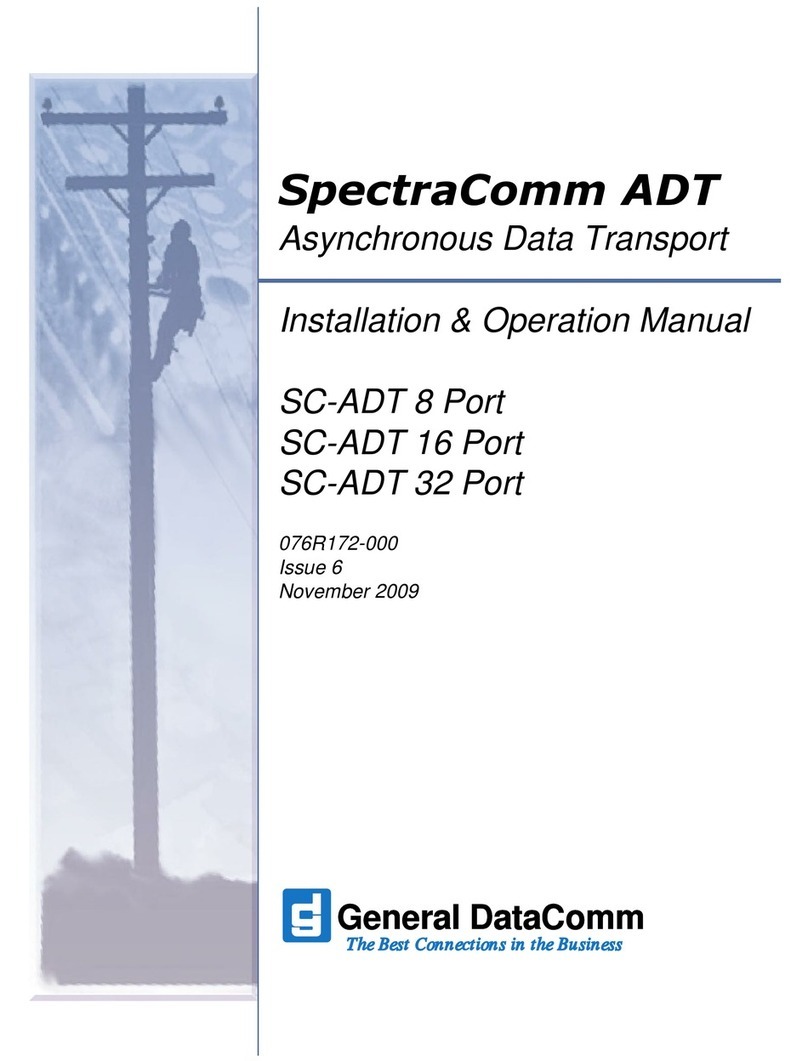
General DataComm
General DataComm SC-ADT 8 Port User manual
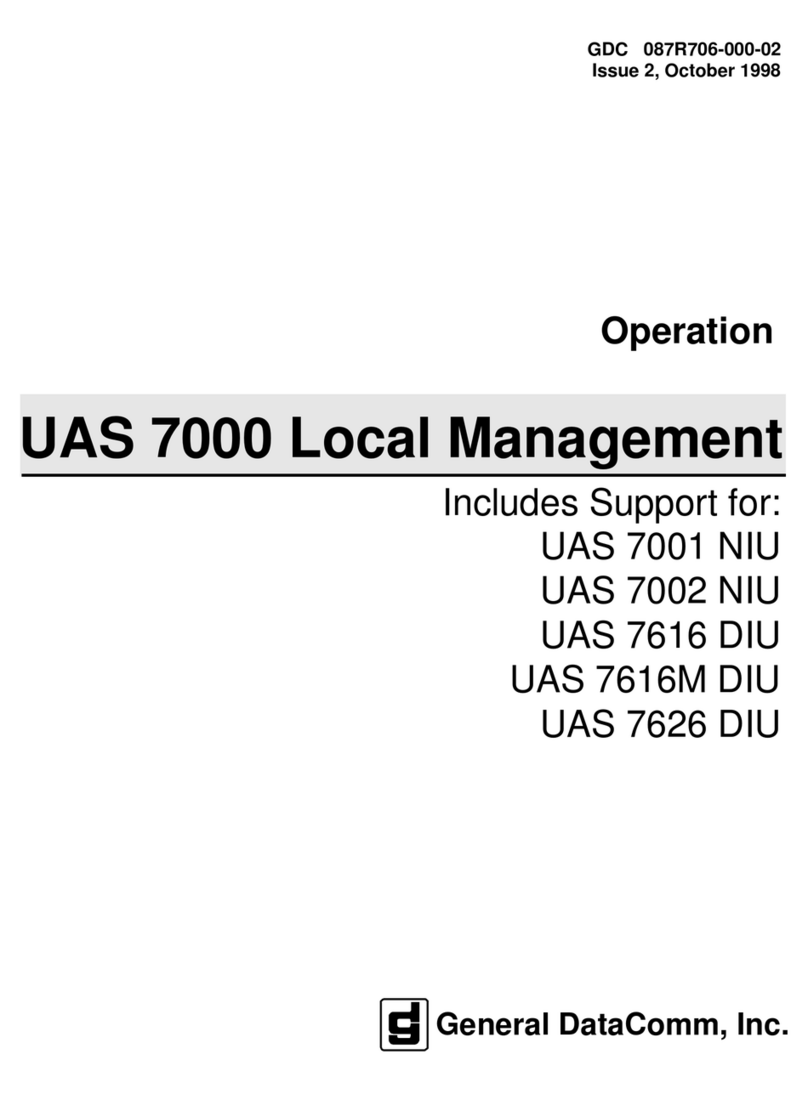
General DataComm
General DataComm UAS 7000 Instruction Manual
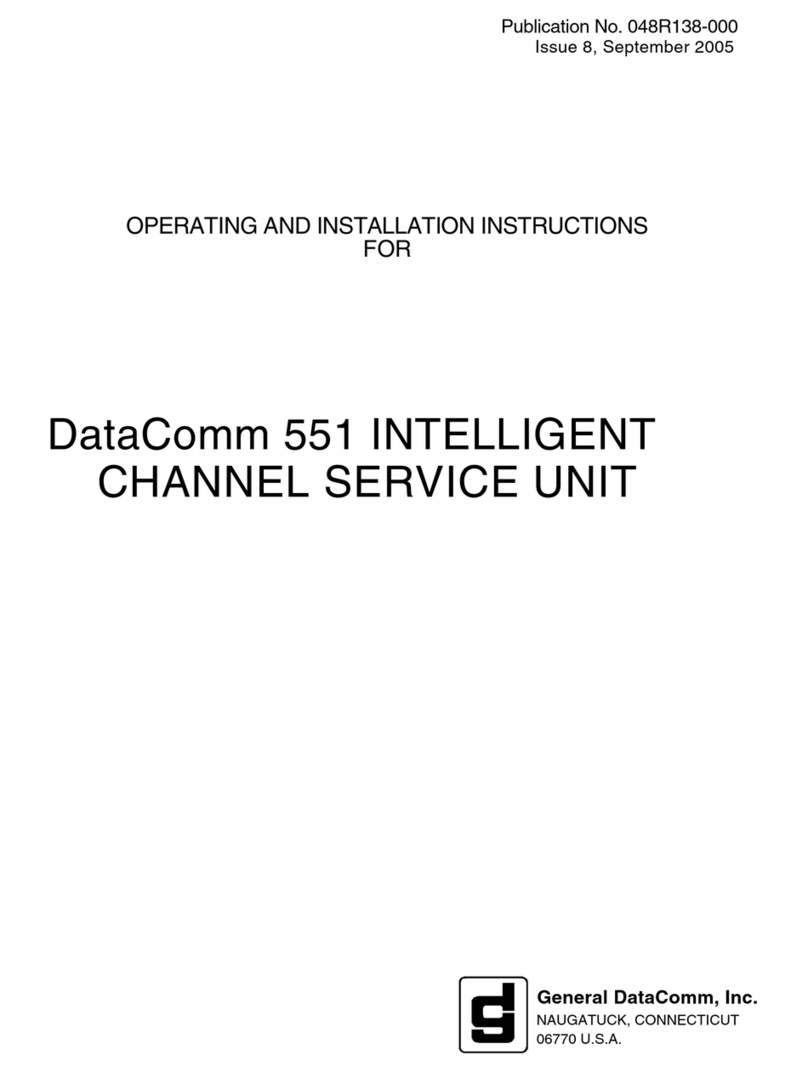
General DataComm
General DataComm 551 User manual

General DataComm
General DataComm SpectraComm 800 T3 User manual
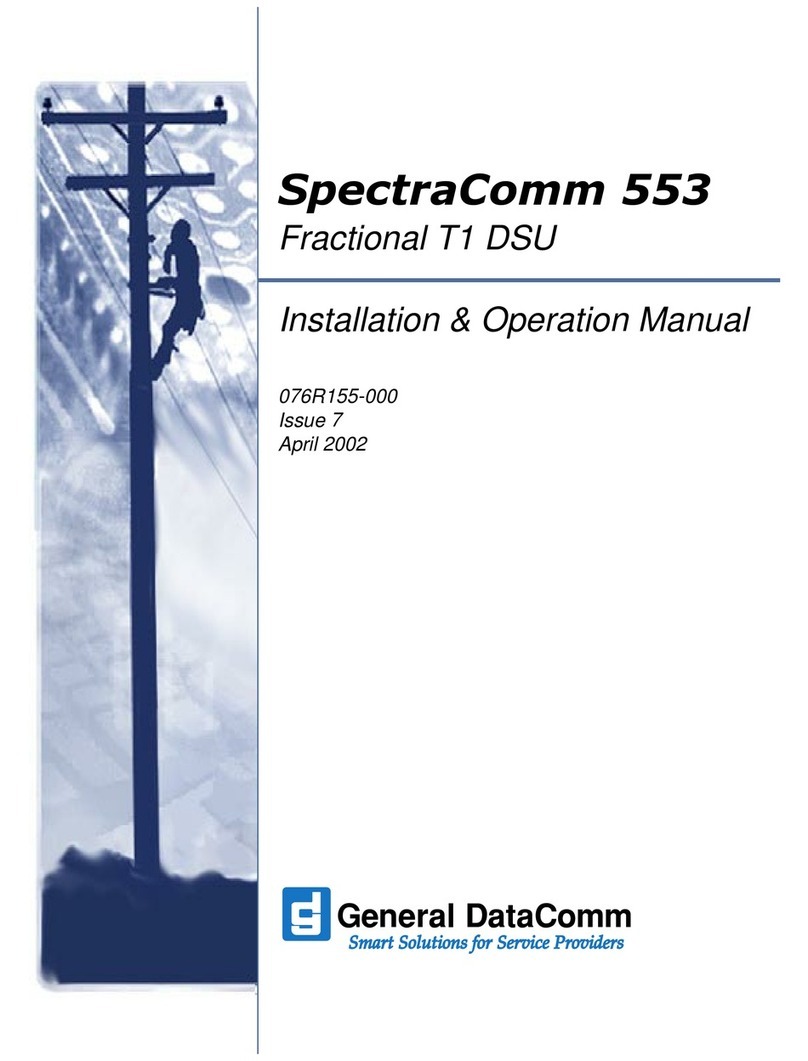
General DataComm
General DataComm SpectraComm 553 Owner's manual

General DataComm
General DataComm DeskTop T1 Owner's manual
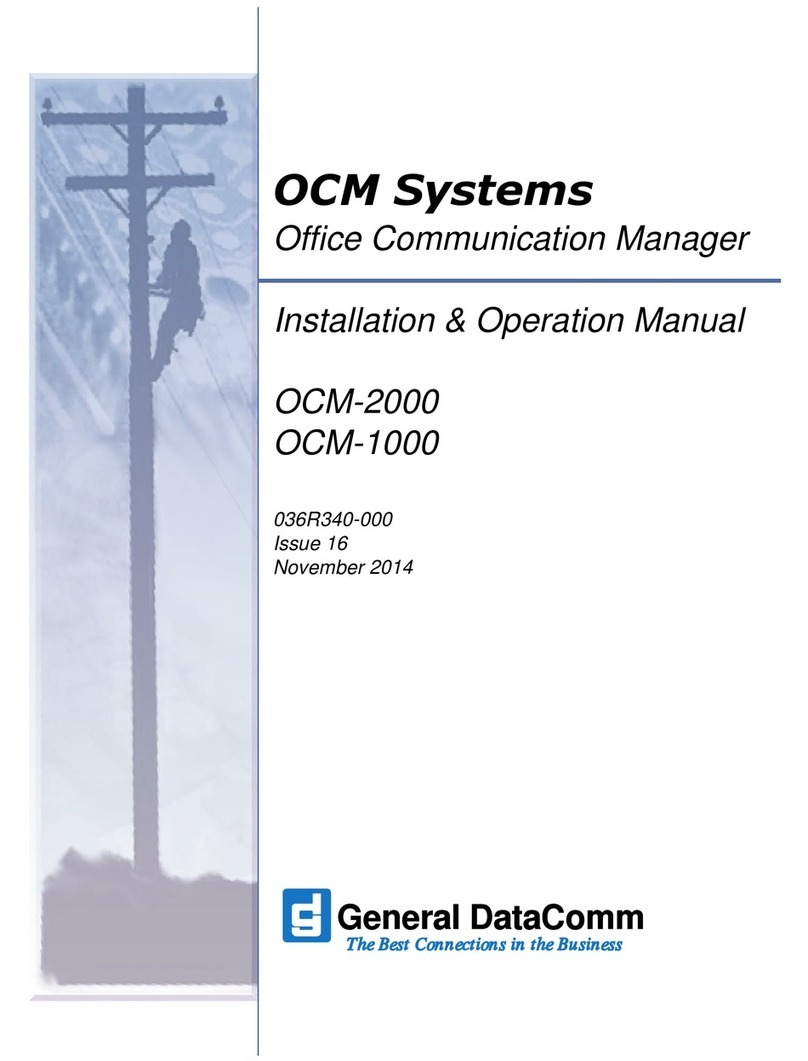
General DataComm
General DataComm OCM-2000 User manual
